and the distribution of digital products.
DM Television
How to create a social media portfolio (free template + examples)
When it comes to landing your next social media client or gig, showing is better than telling. That’s why you need a social media portfolio that highlights your creative content, savvy strategies, and remarkable results.
With some guidance from Brittani Fagal, Founder of the SHE Collective, we’ll show you how to build a portfolio that shows off your brilliance and stands out in every hiring opportunity.
Bonus: Download a free, fully customizable social media portfolio template to make your work shine — and land more clients.
What is a social media portfolio?A social media portfolio is a curated collection of past work highlighting your skills, processes, and successes. It typically includes examples from social media campaigns — along with their context and results — and some information about you as a social media professional.
You’ll use your social media manager portfolio to help you land new freelance gigs, get full-time jobs, find potential clients for your agency, or even negotiate a better salary by showcasing your best work in one impressive package.
Why do you need a social media portfolio?You could just hand out resumes, since they list your experience. But employers and marketing directors have a lot on the line, and a social media manager portfolio will help you:
- Prove your social media expertise, skills, and successes with real work.
- Be more memorable in interviews or client pitches.
- Show how you think through, plan, and execute a social media strategy.
- Simplify your application and pitch process since everything is already packaged together.
- Instill confidence in future employers that you are the ideal candidate, among all other content creators, for the job.
We don’t just want you to have a portfolio. We want you to have the portfolio — the one that proves you’re the best at your craft. “Include a short intro, the niche you serve, your strongest work, and results that back it up,” Fagal says.
Here are some more specifics:
- Contact details: Place your contact details in several highly visible locations around your portfolio. At a minimum, include your email address. Links to your website and LinkedIn page are also helpful. Double-check any hyperlinks.
- Professional images: Since you’re applying for a visually intensive job, splash in a few professional headshots and “candid” photos of yourself. Throw in some background images of things like your office, desk setup, you in action working, that sort of thing. Just make sure it screams, “I’m a creative, meticulous professional.”

Source: Kristine Gumera
- Clean, clever copywriting: You’re creative, concise, and clever. Let that shine through in the words you write for your portfolio. And of course, make sure it’s error-free.
- Your resume: Your resume provides employers with a comprehensive overview of your experience and education. With a glance, they’ll know how long you’ve been at the social media game, what tangential expertise you possess, and who you’ve worked for and with.
- Best performing social media posts: This is the heart of your social media marketing portfolio. Create a collage of the posts you’re most proud of and the ones that racked up a ton of engagement. Include a variety of post types (still image, carousel, video, etc.,) and arrange them aesthetically.

Source: BM Social
- Campaign highlights: Present a few of your most successful social media campaigns and present them holistically. Treat them like case studies and include the original business challenge, goal, method, and outcome (focusing on tangible results). If possible, go upstream from social media and explain the positive effects these campaigns had on the business.
- Services and industries: Are you a photographer? Do you offer big-picture marketing strategy? List all of that out in a clear list of services. And if you focus on a niche industry, include it here as well.
- An “About me” page or biography: Your “About me” page is an opportunity to go beyond your experience and share more about the person behind the professional. Say what you’re passionate about and mention high-profile brands you’ve worked with.

Source: Alison Rojas
- Testimonials: Finally, don’t forget that social proof! Share the glowing reviews and kind-worded thank you messages you’ve received from your best customers. Whenever possible, include the name, title, and company of the reviewer. And add logos from any notable businesses you’ve supported (if allowed).
The most challenging step in creating a social media profile is the first one. Let us give you a big head start with Hootsuite’s free social media profile template.
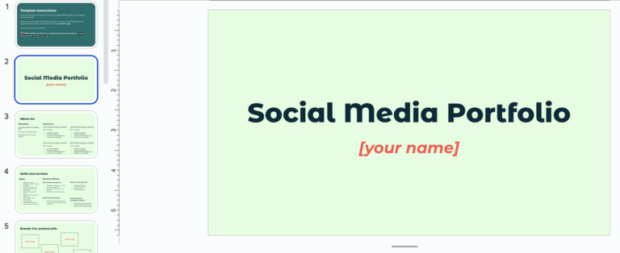
The template has everything you need to build and optimize a beautiful social media portfolio, including a skills section, campaign highlights, a customer testimonial page, a services list, and more!
How to create a social media portfolio (Step-by-step) 1. Choose the right format or platformStep one is to decide which platform you want to build your portfolio on. There’s no one right answer here, so consider how you’ll use it, your comfort level with each option, and whether you’ve seen employers request a particular version.
Here are some options to consider:
- Website: A popular option because it has a place for everything, it’s easy for employers to navigate, and it looks really professional.
- Google Slides: If you plan to present your portfolio personally, a format like Google Slides or PowerPoint would be a good choice.
- Canva: Canva has lots of pre-made design templates to add a little visual flair to your social media portfolio.
- Notion: Workspace applications like Notion are intuitive to work with, so if you’re not particularly savvy with these apps, then this may work well for you.
- PDF: Many application processes want a format like PDF included as an attachment, so you may need to consider creating a version of your portfolio this way.
- Dedicated social media account: You are applying for social media manager gigs, after all. One way to show off your prowess is to create a new account to house your best work. Just make sure you include some context and results in the comments.
“Really hone in on your personal branding and let your personality bring your work to life.”
“Social media platforms like LinkedIn, Instagram, and TikTok also work as great portfolios when you are intentional with what you are posting with the goal of building a portfolio, because viewers can see the real results front and center,” says Fagal.
2. Start with a strong bio and imageEvery SMM will have examples. Your bio page is a chance to really stand out. Give people a sense of who you are and why it’s great to work with you.
This is also where you want to place that highly professional headshot or your best “in action” image.

Source: She Collective
3. Add a personal tagline or mission statementThis should be a tight, memorable, and uniquely you phrase.
Include a sense of what you do and how it’ll help the business that hires you. Something like, “Helping brands grow through scroll-stopping content.”
4. Showcase your best social media content (with context)Think of this section like mini-case study vignettes. Each one should include an example post, some context about the goals and strategy, and the results or performance.
You can use either screenshots or embeds for the posts. If you choose to use embeds, just make sure to update your portfolio if the post is removed.
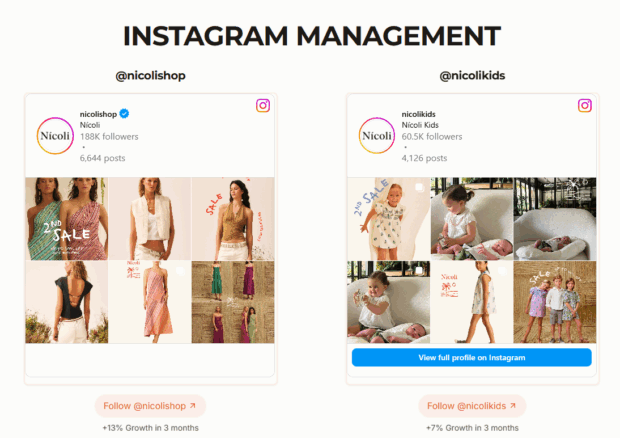
Source: Teresa Almoguera
A note about non-disclosure agreements here.
If you’ve signed an NDA, you probably can’t share the work publicly. Your option is to ask for explicit permission to share it with a specific business. But ideally, try to negotiate this before you sign an NDA with a new client.
5. Highlight performance with real dataMost employers will look for SMMs who can move the growth needle for their business. So, be bold here and show off the results of your work. Include a variety of post-level metrics and big-picture campaign results.
This part will be really easy if you have access to Hootsuite’s analytics dashboard.

The exact metrics you mention will depend on the particular campaign. “It really depends on your niche focus and the goals of your clientele,” says Fagal.
“For organic growth, prioritize reach, saves, shares, and engagement rate. For conversion-focused work, click-throughs, link taps, and direct sales are your go-tos.”
Here’s a list to consider:
- Follower growth
- Saves and shares
- Click-throughs and link taps
- Engagement or engagement rate
- Reach and impressions
- Sales and leads driven from social media
- Brand mentions
- Usage of branded hashtags
- UGC created for the brand
There’s nothing quite like client love to attract new business opportunities.
Be sure that you have the client’s permission to share their words before including them in your portfolio. Of course, if they post a public review on Google or social media, that’s fair game for your portfolio collection.
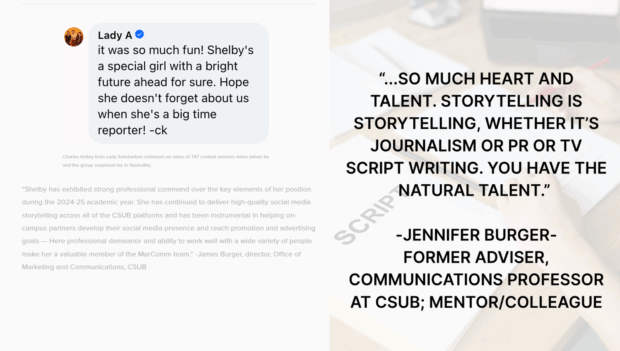
Source: Shelby Parker Creative
The same goes for the collection of brand logos you’ve worked with. Ask if it’s okay to post them in your portfolio, then place them prominently.
7. Make it easy to navigate or downloadAnyone reviewing your portfolio is likely looking at a dozen others. Make it easy for them to find all the best bits quickly so they come away with the complete picture of you and your work.
How you do this depends on the platform you’ve used. If it’s a website, include a clearly labeled menu of page links and in-content links. If it’s a PDF or Google Docs portfolio, add a table of contents and an easily downloadable link (and remember to share the link with the viewer!).
5 great social media portfolio examples to inspire youLet’s examine why some exceptional SMM portfolios work so you can replicate their success.
Maria Moore: Incredible highlight reel
Source: Maria Moore
- Type: Freelancer
- Platform used: Website
- Strength: Well-organized layout, concise copy, highlight reel
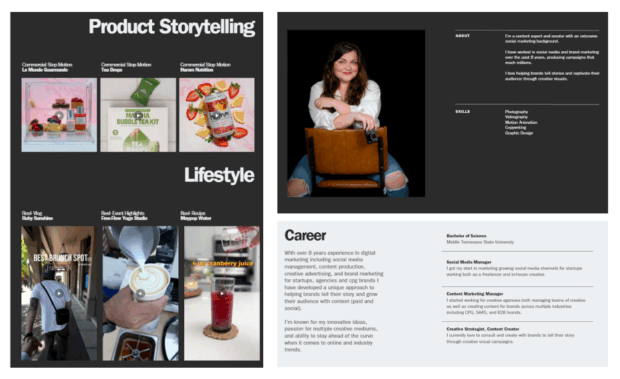
Source: Maria Moore
Maria’s portfolio website features clearly defined sections with tight copy, allowing you to scroll through and view all the good stuff, quickly. Its standout feature, though, is a short and high-energy highlight reel that takes you through some of her most creative visual work.
The Content Savvy
Source: The Content Savvy
- Type: Agency
- Platform used: PDF
- Strengths: Comprehensive, visually cohesive, case study-like examples

Source: The Content Savvy
This social media marketing agency works in various industries, and the table of contents helps viewers navigate to each. The agency’s portfolio does a great job of presenting a short case study — complete with a short narrative—for each example.
Jennifer Harriman: Creative design
Source: Jennifer Harriman
- Type: Freelancer
- Platform used: Canva and PDF
- Strengths: Fun and creative graphic design elements, both a Canva site and a PDF of her best work
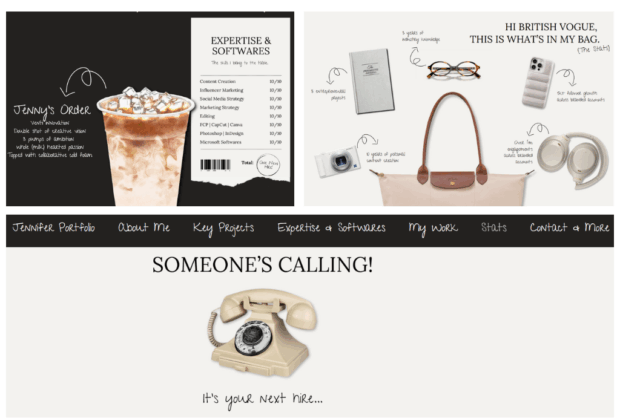
Source: Jennifer Harriman
Jennifer’s portfolio is fun and creative, which makes you want to scroll to see what’s next, similar to a great social media feed.
Fresh Content Society: Tons of social proof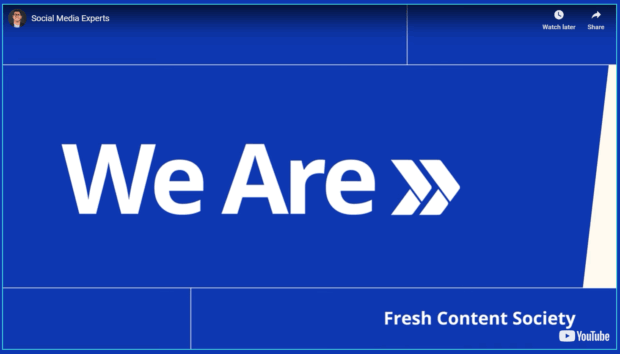
Source: Fresh Content Society
- Type: Agency
- Platform used: Website
- Strengths: Several types of social proof, well-written case studies, and different types of content creation are represented in the examples
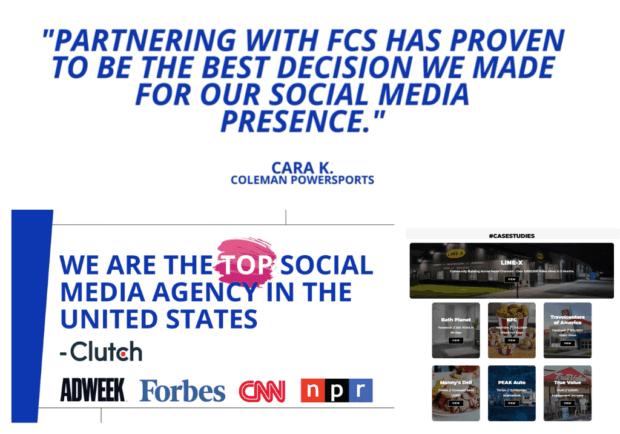
Source: Fresh Content Society
Fresh Content Society prominently features customer reviews, industry accolades, case studies, and customer logos throughout its portfolio and website. When you only have a short time to convince someone you can do the job, that’s a great way to do it.
Julia Offenberger: Classic, clickable portfolio
Source: Julia Offenberger
- Type: Freelancer
- Platform used: Website
- Strengths: Professional “About me” page, clickable tiles for easy example review, and detailed strategy examples
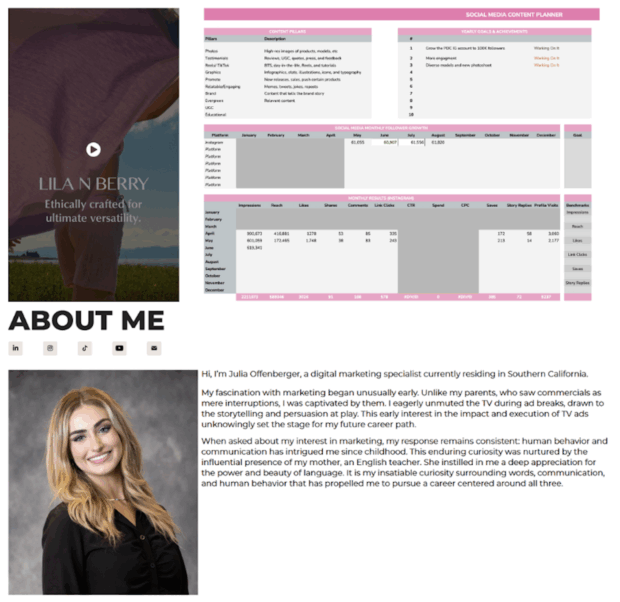
Source: Julia Offenberger
It’s hard to visualize the process, but Julie does this brilliantly by occasionally sharing a screenshot of her project management app. The clickable tiles on her portfolio’s main page help visitors quickly access the most relevant examples.
4 pro tips to make the most of your social media portfolioFagal shares her top tips for creating a standout social media manager portfolio.
1. Make your portfolio the digital version of youThe goal of creating a great social media portfolio is to stand out in a crowd when it comes time to hire.
“Think of your portfolio like a digital version of you,” Fagel says. “To make it stand out, drown your portfolio in personality! It shouldn’t look or feel like another resume with added visuals.”
Besides the basics, Fagel notes that she likes to weave in a few behind-the-scenes details, too Try explaining your strategy or writing process. Or tell a little about your workspace — something that positions you as a thoughtful professional who’s geared up for the job.
2. Tell a story with the metricsResults are the most important part of your SMM portfolio. They prove that your creativity and expertise can help a client or company grow.
To make those cold, hard numbers more impactful, include the context of how they came to be. “What matters most is tying those numbers to a story,” Fagal shares.
“Explain the story behind the piece, the strategy, and why it performed well to show that it wasn’t just a lucky chance with the algorithm, but that you put work and strategy into what you created.”
In short, Fagal says to “Show them why it worked, not just that it did.”

Source: SHE Collective
3. Tailor it to the job/client you wantYou don’t just want any ol’ social media gig. Ideally, you’ll find one that matches your strengths and interests. Fagal says the examples you choose can help you achieve that goal.
“Choose content that not only performed well, but also reflects the kind of work you want more of,” she suggests.
And what if you’re a beginner and don’t have examples of the work you want to do? “Don’t wait around for someone to give you the chance to prove yourself,” Fagal adds. “Create mockups for the work you want to do and show them why you have what it takes!”
4. Keep it on taskYour portfolio’s job is to get you the job. Review it with a critical eye and make sure everything you include serves that purpose.
“Keep it value-packed and cut out extra noise that doesn’t serve a purpose,” Fagal says. “You don’t need to showcase all of your work, just the best of it. People consume fast, and every second a viewer gives counts.”
And while your creativity should shine through, don’t let it distract people from the message. “Anyone can make cute graphics,” Fagal notes. “Show that you understand the why behind the content, and you’ll stand out fast.”
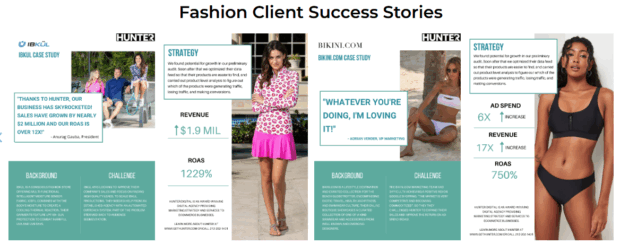
Source: Hunter Digital Marketing
Social media portfolio FAQsLet’s cover a few of the most important questions about social media portfolios.
What is a social media portfolio?A social media portfolio is a curated collection of a professional’s best work, showcasing their strategic skills and successful digital marketing campaigns. It serves as concrete evidence of their ability to grow online communities, manage content, and deliver measurable results for brands.
What should be in a social media portfolio?A strong social media portfolio should feature compelling case studies that outline campaign goals, your strategic approach, and quantifiable results, like engagement rates or follower growth. It should also include a curated collection of content examples you’ve created (e.g., graphics, videos, compelling copy), client testimonials, a professional “about me” section, a list of services, and contact information.
How do I make a social media portfolio with no experience?To build a social media portfolio with no experience, create your own by managing hypothetical brands or offering pro bono work to small businesses. Document your strategic approach, the content you created, and any results you achieved, no matter how small. Then, organize it all on a website or in a PDF or Google Doc.
Should I make a social media portfolio as a student or freelancer?Absolutely! As a student, your portfolio goes beyond your academic transcript to showcase practical skills and project examples. As a freelancer, a portfolio is essential visual proof of your expertise so potential employers know you can deliver tangible results.
What’s the best format for a social media portfolio?The best format for a social media portfolio depends on how you’ll use it and your comfort level with each potential platform. A website is versatile and easy to share, while many job applications require a PDF of your portfolio.
Save time managing your social media presence with Hootsuite. Publish and schedule posts, find relevant conversions, engage your audience, measure results, and more — all from one dashboard. Try it free today.
Get startedThe post How to create a social media portfolio (free template + examples) appeared first on Social Media Marketing & Management Dashboard.
- Home
- About Us
- Write For Us / Submit Content
- Advertising And Affiliates
- Feeds And Syndication
- Contact Us
- Login
- Privacy
All Rights Reserved. Copyright , Central Coast Communications, Inc.